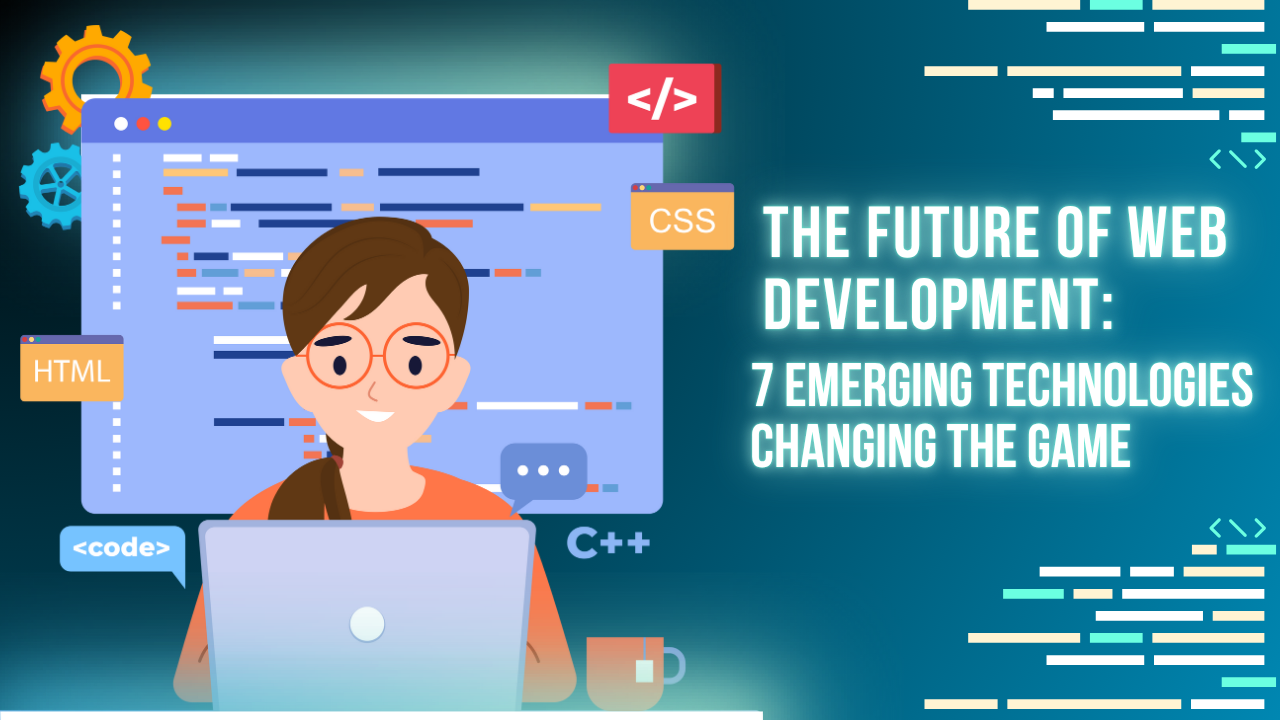The Future of Web Development: 7 Emerging Technologies Changing the Game
Introduction: The Web Is Changing — What About You?
Development of the web has changed psychologically.
Static pages and basices of UIs are now rather foreign concepts. These days, users want the site experience to be fast, interactive with gentle human touches, immersive, and keeping up with seamless rhythm across an array of devices, places, or basically position and speed.
And herean ironic situation: most sites have still been unable to match with expectations that are growing day-by-day.
If your web application is still being made on mixes and tech that older persons used to build, or on generic templates, then the site is not just misbehaving, it is silently losing its customers, its visibility on search engines, and its identity; the businesses that nowadays have made a mark are the ones that have chosen to build from what is next, not from what worked before.
In the following article, we shall look at 7 modern technologies that are reshaping web development and how they provide the best ports for businesses to provide digital experiences with faster, smarter, and next-ready fronts.
1. AI-Powered Development and Smart Automation
Artificial intelligence is changing the means of web-site-building, optimizing, and personalization.
For developers, AI tools like GitHub Copilot or Tabnine can speed up coding by predicting and generating code snippets. On the user's end, though, that's where the real power manifests: recommendations, smart search results, automated chatbubbles, and content that changes on the fly according to how the user interacts with the app.
Besides allowing businesses to save time, AI-assisted interactions create more intelligent experiences for the end-user.
From AI-based copywriting to predictive analytics, this technology bridges the content-gaps for businesses, enabling them to serve content quicker and better while increasing engagement, conversion, and retention rates.
Why it matters:
AI in web development improves UX, automates workflows, and creates new channels for Personalization of each digital touchpoint.
2. Web3 And Decentralized Applications
Web3 is an application of the decentralizing principle to the Web in harmony with the new paradigm of ecosystems beyond platforms.
Being interface-less sites where users use decentralized applications running with blockchain infrastructure instead of centralized servers and providers give users control over their data, identity, and digital assets.
The entire chain Web3 gives openness and trust in Online experiences most often NFT platforms, token-based outside mechanisms for access, or smart contract-based marketplaces.
This transformation is most critical for start-ups and platforms that must provide security, fairness, and alignment of values with those of their users.
Why it matters:
With its decentralization, blockchain and Web3 thus open newer avenues for ownership, monetization, and user engagement for the enterprises.
3. Headless CMS and API-First Architecture
Legacy content management systems are slow, bloated, and difficult to scale. Headless CMS—a backend-only content repository that streams data out to a client frontend using APIs that enable the developer to build any kind of UI—comes to the rescue.
Essentially, it enables marketing product teams to hold content in one location, in concert across custom developer experiences on the web, mobile, apps, or even smart devices.
Regardless of Strapi, Sanity, or Contentful, headless CMSs bring speed, security, and non-stop scalability that allow startups and high-growth brands to accelerate.
Why it matters:
API-first is adaptive content rendering and speeding up frontend performance—the spirit of SEO and UX.
4. Progressive Web Apps (PWAs)
This boom enables apps to be showcased on excellent platforms of browser and mobile applications.
They load instantly, work offline, and have essential app features such as push notifications, install icon, smooth animations, all without the bother of a traditional app store or a gigantic download.
In countries where mobile-first implementation is no longer an option but a hard mandate, PWAs are the way to go in giving fast and reliable experiences to users on whichever device they choose.
Why it matters:
With the PWAs, bounce rate goes down, Core Web Vitals go up—and the user feels native, only minus the native price.
5. The Motion UI and Micro-Interaction
The first impressions are now digital-first impressions and a motion forms a language on its own.
Be it a loading spinner or hover state, a scroll-triggered animation or a button click, motion UI makes interactions smoother and intuitive, hence keeping the user engaged.
But far from mere decoration, their use extends to communicate: guide the users, express progress, confirm actions, and give emotional voice to your brand.
Why it matters:
Motion UX increases the clarity of an interface, helps retention, and imparts that one life-touch to interfaces in advance of as flat representations.
6. Augmented Reality (AR) on the Web
Augmented reality is no longer gaming exclusive — it's getting serious business in e-commerce, real estate, furniture, and education.
Thanks to WebAR technologies such as WebXR and Three.js, consumers can try before they buy, interact with 3D models, or enjoy immersive tours — all within their mobile browser.
For example, a consumer purchasing sunglasses is able to see themselves wearing different different models in real-time — without needing to download an app. That's hip — but it's conversion power.
Why it matters:
AR adds depth, context, and interactivity to the web, creating experiences that are sci-fi-like but with very real business goals.
7. Voice Search Optimization and Conversational UI
"Hey Google, show me a digital agency close to me."
You just spoke for millions of voice-triggered searches every day with that line. But most websites are not yet voice search optimized.
Conversational interfaces and voice search SEO are changing how people interact with content — from question-style keywords to AI-driven chat interfaces.
Final Thoughts: Build for What's Next
If there’s one thing we’ve learned about the web — it doesn’t stand still.
New technologies emerge, hopes expand, and firms that do not change are left behind. But those who build with flexibility, speed, and innovation in mind gain more than just visibility — they win long-term market leadership.
Final Thoughts: Building for What's Next
If anything is sure about the web — it won't stand still.
New technologies emerge, expectations rise, and businesses that fail to change are left behind. But those who build for flexibility, speed, and innovation harvest more than visibility alone — they harvest long-term market leadership.
At Nebula X, we don't merely hop on trends — we create what's next. From headless architecture to Web3, PWAs, and AI-optimized UX, we help startups and businesses develop digital products tomorrow-ready — today.
Want to Build a Future-Ready Platform?
Talk to our team at Nebula X
We’ll help you choose the right tech stack, design with SEO and UX in mind, and build a digital experience that scales with your vision.
 Blog Details
Blog Details

 Hisham Helaly
Hisham Helaly
Please log in to post a comment.